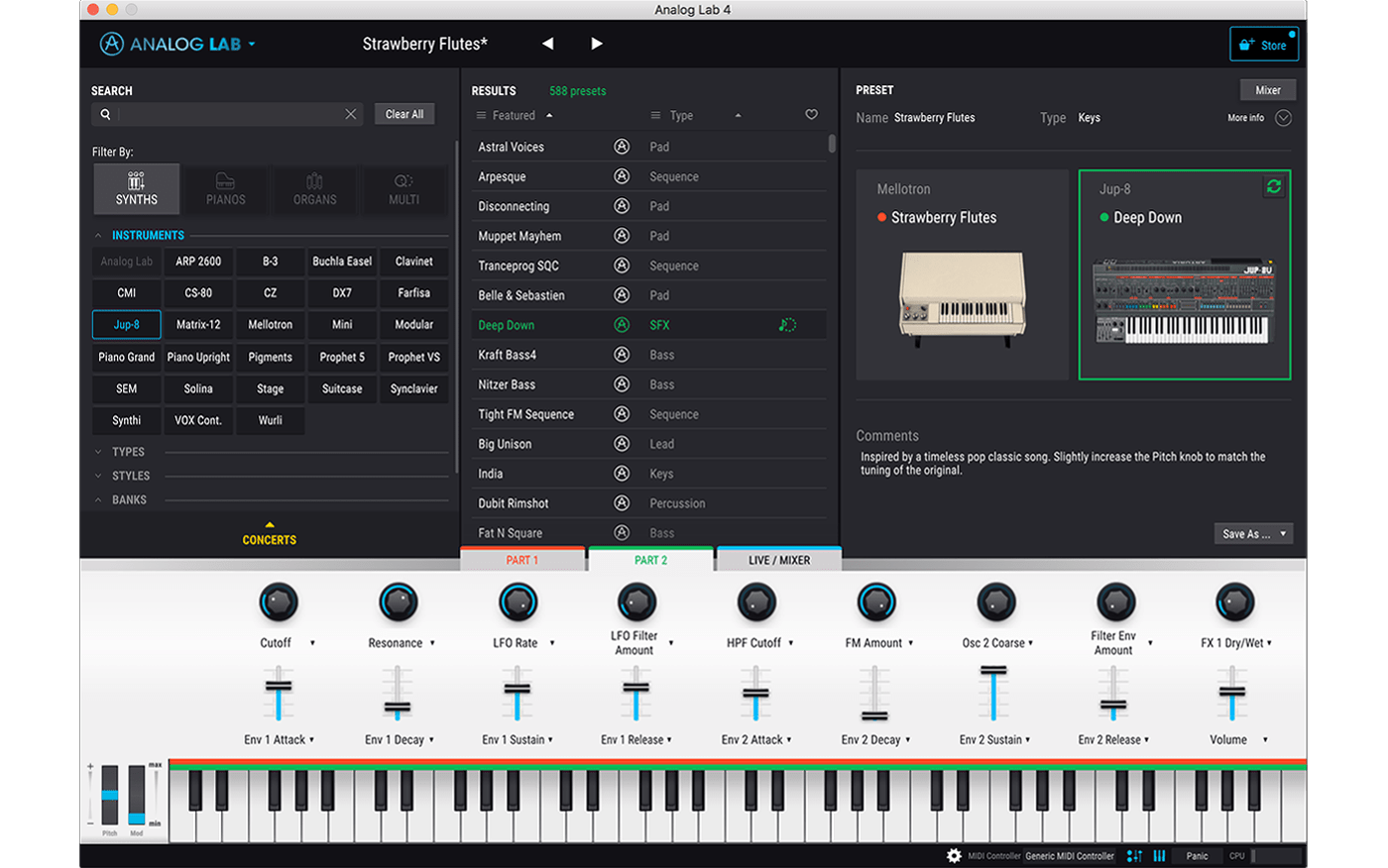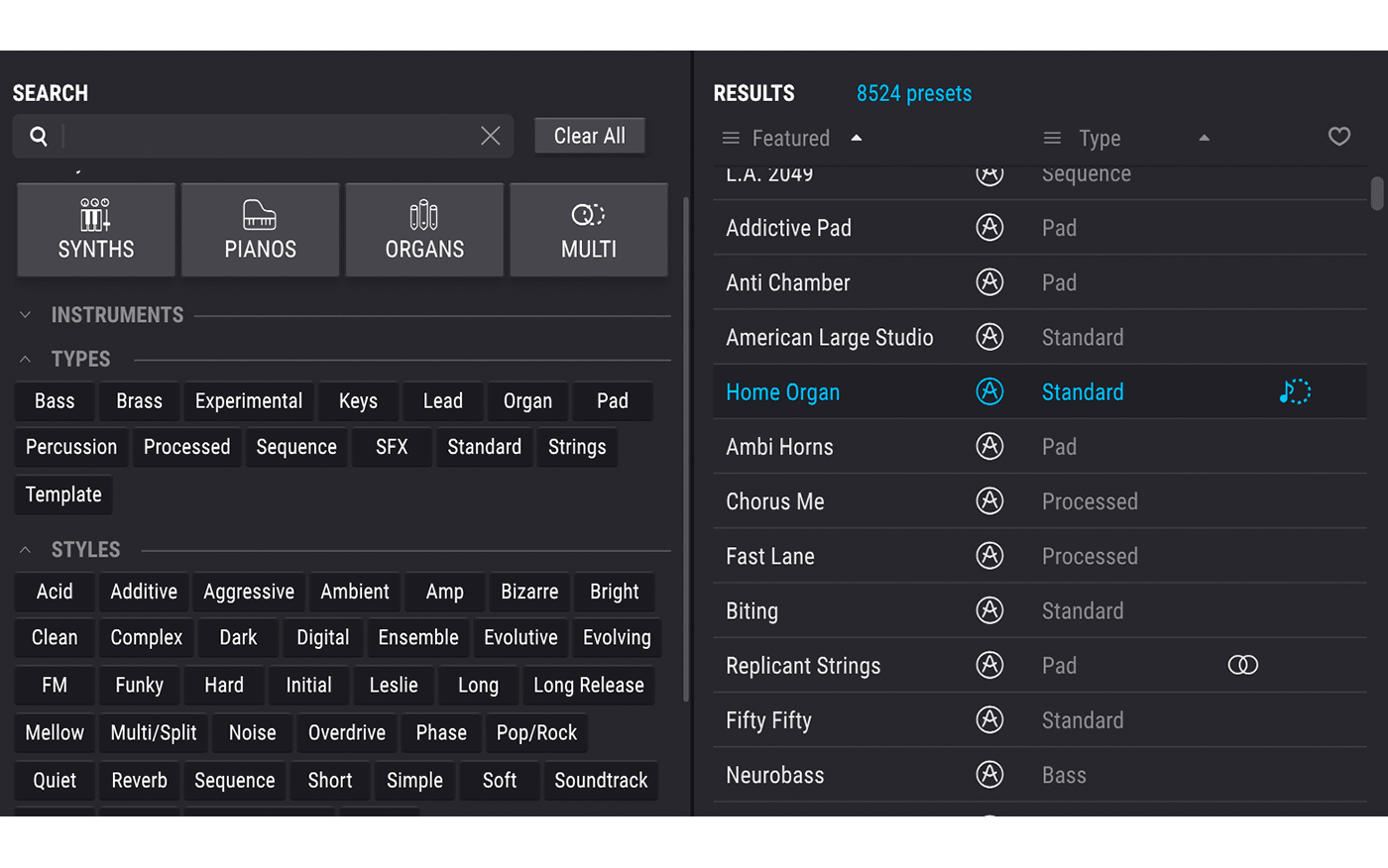




V Collection 7
Rent-to-own
$24.99/mo. for 20 months
Try free for 3 days Cancel at any time No hidden fees or interest
10 Analog Synths
Enjoy the same controls, sequencers, and even idiosyncracies that made these instruments some of the most influential analog synths ever played.
When EMS launched the Synthi 1972, it stood out. Its small size, unique patch pin matrix, and massive, unpredictable sound was like no other. It quickly became the instrument of choice for groundbreaking musicians like Brian Eno, Pink Floyd, and Jean-Michel Jarre. Arturia’s recreation adds advanced modulation and powerful effects.
Originally devised in 1973 for musicians in search of a performative and "portable" instrument, the Buchla Music Easel quickly earned a cult following. Built on a West-coast approach to synthesis, strange sequences, and left-field sound design, it was capable of sounds both organic and alien. This version includes Gravity, a physics-based synth engine that takes the Easel’s sound even further.
The Moog monosynth legendary for its thick, warm basses and heavy-legged leads gets a faithful recreation and holistic update from Arturia and Bob Moog himself. Enjoy the sound found on countless records, but with new features like polyphony, a dedicated mod matrix, and preset morphing.
Featuring a fat but airy sound made popular by Prince, Duran Duran, Moby, and Depeche Mode, this "perfect" polysynth features the original filters, VCO sync, and an arpeggiator. New features include complex LFO combos, modulation-targeted FX, and an advanced step sequencer.
Popularized by Stevie Wonder, Toto, Vangelis, and ELO, the CS-80 set itself apart from the competition with its rich sonic textures and performability, which stemmed from its ribbon controller, polyphonic aftertouch, and parallel signal paths. Enhancements include new mod routings, an arpeggiator, and stereo delay.
The first fully programmable and polyphonic subtractive synth, the Prophet 5 has a sound that was highly influential in the late 70s (and today). The later Prophet VS used vector synthesis and featured an X-Y joystick for morphing between its quad oscillators and 128 waveforms. Arturia's version combines the two.
The first of its kind, this synth’s CV-centered patch interface unlocked new creative flexibility and helped sprout the electronic music revolution. Arturia's version has the same huge sound, but with programmable presets, 9 VCOs, and rare original modules.
Capable of huge tones, complex textures, split melodies, and interrelated changes, the Matrix-12V could make magic. Arturia's version has the same 12 voices and 15 filters, but with an expanded modulation matrix and more sources to feed it.
The first self-contained synth module by Oberheim featured a unique 12db-octave multimode filter so characterful that it’s been imitated by competitors and hobbyists since. Arturia's recreation adds a modulation matrix, a sub-oscillator, an arpeggiator, portamento, and noise.
This semi-modular synth was able to have its normalized connections overridden with a patch cable, which made it ideal for sonic exploration. The 2600 is responsible for many iconic sounds, including the voice of R2D2. This version is enhanced with polyphony, tracking-generator modules, a 1601 sequencer, and effects.
4 Digital Synths
Play the six digital synths that helped redefine pop music, scored countless films and TV commercials, and gave musicians their first taste of electronic music at home.
Casio’s CZ-101 became ubiquitous in the home and pro studios of the mid eighties with its affordability and sound, achieved through mass production and phase distortion synthesis, respectively. Arturia’s CZ V has the same wave types, patch programming, 8-stage envelopes, LFO-modulated vibrato, and beautiful robot-breath sounds.
Possibly the most influential, revered, and reviled synth, the Yamaha DX-7 has an unmistakable FM sound known by anyone exposed to pop culture since the 80s. Arturia's version is arguably more accessible because they've simplified the notoriously tricky sequencer and added customizable envelopes, extra waveforms, and effects.
Released in 1979, this groundbreaking digital additive synth from Fairlight became the mother of all samplers, revolutionizing pop music and its production. Arturia adds multitimbral, polyphonic slots for sound design, real-time waveform shaping, a sequencer, and a "spectral" synth.
Responsible for the iconic sounds on some of the biggest records, movie scores, and tv themes of the 80s and 90s, from “Apocalypse Now” to “the Princess Bride” to “the X-Files” The Synclavier fused additive and FM synthesis to elicit epic pads, crystalline bells, and evolving textures. Arturia teamed up with the original designer, Cameron Jones, to get every detail dialed.
6 Pianos & Keyboards
These emulations of classic electric pianos and keyboards are physically modeled recreations of the originals. Arturia’s taken everything into account, including cabinet materials, string tension, and mic positions.
If nostalgia had a soundtrack, the Mellotron would be on it. The hazy, wow-and-flutter sound made famous by the more experimental pop bands like The Beatles and the Moody Blues came from this electro-mechanical keyboard launched in 1963, which pulled magnetic tape across a playback head when you pressed a key. Arturia’s version has an FX rack and lets you add your own samples, so that you can change the fundamental sound the Mellotron to anything you’d like.
Arturia used their advanced physical-modeling tech to map out the tonal responses of 12 classic pianos, from concert grands to experimental ivories made from metal and glass. The physical modeling of the instruments allows you to change the treatment of the strings, hammers, sound board, cabinetry, and mic positions.
The Stage-73 and Suitcase-73 recreate the most popular electric pianos to ever exist. These tine-based electric pianos of the 60s and 70s had a rounder sound and longer sustain than the competition, which helped make them more ubiquitous. Arturia's enhancements include a tube amp model and classic effects.
Released in the mid-60s and designed with performers in mind, the humble Hohner Clavinet became the most famous electric keyboard of all time. It was (and still is) used on everything from disco and prog rock to R&B and pop. Arturia's physically modeled recreation allows for endless customization.
This string machine is famous for its lush sound, perfect for rich pads and tearaway textures. The Solina's unique sonics are achieved by marrying octave division--a feature grabbed straight from organs--with modulated choruses. Arturia provides the original mono and stereo versions with added voices.
The wonderful Wurli was reed-based, making it a brighter, tighter electric piano, with its velocity-sensitive roughness earning favor among rock and funk players wanting some grit. Arturia's physically modeled reproduction adds tonal shaping, a guitar amp, a rotary speaker, and effects boxes.
3 Organs
The holy trinity of iconic electric organs, Arturia’s implementations have everything that made these instruments favorites among gig musicians, except a resistance to spilled drinks.
The Hammond B-3's transistor design and electromagnetic tonewheel gave it a beefy sound that other organs simply couldn't have, making it a constant companion of musicians since its release over 50 years ago. Arturia's homage includes a rotary speaker and drawbar modulation for syncopated effects.
With the same drawbar design of the Hammond but at a much lower price, the transistor-based Vox Continental had a sound that was part-synth, part organ, and strong enough to power the British Invasion. Arturia version includes the later J70 alternative, extra waveforms, a rotary cabinet, and effects.
This transistor organ had a light, airy sound that went perfectly with the pop sounds of the 60s, a welcome departure the more forlorn Hammond or the softer-toned Vox. Arturia enhanced this recreation with user-definable waveforms, DAW sync for tremolo and repeat, and integrated effects.
Experiment with Analog Lab
V Collection 7 includes full access to Analog Lab 4, a streamlined version of all 24 instruments. Its lightweight interface and abbreviated controls allow you search, browse, and audition all the presets from the full V Collection, without having to open each instrument first. Use the new FX section to add color to your sounds, and use Live mode when you’re performing for real-time access to everything you need.

8000 starting points
V Collection 7 ships with over 8000 breathtaking presets made by professional sound designers and musicians, including 600 not found in previous collections.

Product Information
- Overview
- V Collection 7 puts some of the most influential instruments at your fingertips with circuit-accurate recreations of iconic synthesizers, string machines, electric pianos and organs.
- Arturia’s proprietary algorithms and physical modeling ensure that each instrument sounds like the original, and this obsession over accuracy isn’t just relegated to the instruments’ expected sounds. They’ve also reproduced the idiosyncrasies that made them more memorable, including infamous drifting oscillators, timbral qualities of the speaker cabinets, and the obtuse workflow of some of the sequencers. Unlike the original instruments, these are augmented with features that fill them out, like effects, presets, and different mic positions.
- What's included:
- - 3 instruments that are new to 7: Mellotron V, Synthi V, CZ V
- - 24 instruments in total: Clavinet V, CMI V, DX7 V, Buchla Easel V, Synclavier V, B-3 V, Mini V, Mellotron V, Synthi V, CZ V, Piano V, Stage-73 V, Matrix-12 V, Farfisa V, Solina V, SEM V, Wurli V, Jup-8 V, ARP 2600 V, CS-80 V, Prophet V, VOX Continental V, Modular V, Analog Lab 4
- - Redesigned preset browser for fast access to sounds
- - Simple MIDI mapping to any keyboard controller
- - In-app tutorials
- - High-res GUI that supports large displays
- - Arturia’s proprietary physical modeling technology, ensuring that each instrument sounds and behaves exactly like the original
- - Arturia’s proprietary physical modeling technology, ensuring that each instrument sounds and behaves exactly like the original
- - Over 8000 high-quality presets made by sound designers and musicians
- System Requirements
- For the most up-to-date system requirements and host compatibility details, please visit the manufacturer's website
- Mac OS X 10.10+
- Windows 7+ (64-bit)
- 12GB of free hard disk space
- Works in Standalone, VST 2.4, VST 3, AAX, Audio Unit (64-bit DAWs only)
Splice Requirements
While renting software through Splice, the Splice Desktop App must be opened every three days. The current operating system requirements for Splice Desktop are:
- — macOS 10.15+
- — Windows 10+
Learn more about the Splice Desktop App's operating system requirements.

